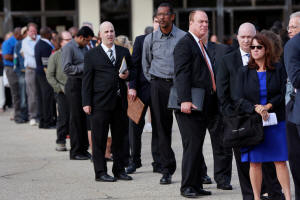U.S. job growth slows; millions experiencing long bouts of unemployment
 Send a link to a friend
Send a link to a friend
 [November 07, 2020] By
Lucia Mutikani [November 07, 2020] By
Lucia Mutikani
WASHINGTON (Reuters) - The U.S. economy
created the fewest jobs in five months in October and more Americans are
working part time, underscoring the challenges the next president faces
to keep the recovery from the pandemic on track as fiscal stimulus dries
up and new COVID-19 cases explode across the country.
The Labor Department's closely watched employment report on Friday also
showed 3.6 million people out of work for more than six months.
Democratic presidential candidate Joe Biden took the lead over President
Donald Trump in the battleground states of Pennsylvania and Georgia for
the first time on Friday, putting him on the verge of winning the White
House.
"Initially, the recovery was breathtaking, but has lost much steam,"
said Sung Won Sohn, an economics professor at Loyola Marymount
University in Los Angeles. "With no fiscal stimulus and the resurgence
of coronavirus, job gains will be tougher to achieve in the future."

Nonfarm payrolls increased by 638,000 jobs last month after rising by
672,000 in September. That was the smallest gain since the jobs recovery
started in May and left employment 10.1 million below its peak in
February.
Employment was held back by the departure of 147,000 temporary workers
hired for the 2020 Census. A 271,000 increase in leisure and hospitality
jobs accounted for about two-fifths of the payrolls gain last month.
Employment in professional and business services increased by 208,000,
with about half in temporary help services. Manufacturing added 38,000
jobs, while construction payrolls increased 84,000.
The loss of temporary Census jobs and further layoffs at cash-strapped
state and local governments cut overall government employment by 268,000
jobs. Economists polled by Reuters had forecast payrolls advancing by
600,000 jobs in October.
Though private payrolls increased 906,000 last month, the labor market
recovery has a long way to go.

"Employment is still only at its late 2015 level," said Gus Faucher,
chief economist at PNC Financial in Pittsburgh, Pennsylvania. "And at
October's pace, it would take about 16 months for employment to return
to its pre-pandemic level."
A contested election reduces the chances of another coronavirus rescue
package from the government this year. Even if more fiscal stimulus is
agreed on, it will likely be smaller than had been anticipated before
the election.
That shifts the spotlight to the Federal Reserve. The U.S. central bank
kept interest rates near zero on Thursday. Fed Chair Jerome Powell
acknowledged the pace of improvement in the economy and labor market had
moderated, noting that the recovery would be stronger with more fiscal
support.

[to top of second column] |

People wait in line to enter the Nassau County Mega Job Fair at
Nassau Veterans Memorial Coliseum in Uniondale, New York, U.S.
October 7, 2014. REUTERS/Shannon Stapleton

"The Federal Reserve is going to end up doing more stimulus rather than scaling
it back," said James Knightley, chief international economist at ING in New
York. "This is especially so if political tensions remain high and get in the
way of a swift fiscal response."
Stocks on Wall Street were trading lower. The dollar slipped against a basket of
currencies. U.S. Treasury prices fell.
RISE IN PART-TIME WORKERS
More than $3 trillion in government coronavirus relief for businesses and
workers fueled a historic 33.1% annualized rate of economic growth in the third
quarter. That followed a record 31.4% pace of contraction in the April-June
quarter.
Lack of fiscal stimulus and spiraling new coronavirus infections put the economy
on a sharply slower growth path heading into the fourth quarter. Restaurants and
gyms have moved outdoors, but cooler weather and the resurgence in COVID-19
infections could leave many in trouble.
Even if state and local governments do not impose new restrictions on
businesses, consumers are likely to stay away, fearing exposure to the
respiratory illness. The United States set a one-day record for new coronavirus
cases on Wednesday with at least 102,591 infections, according to a Reuters
tally.

Though small and medium-sized businesses have suffered most from the pandemic,
large corporations have not been spared. Exxon Mobil last month announced 1,900
layoffs in the United States. Boeing said it expected to eliminate about 30,000
jobs, 11,000 more than previously planned, by end-2021.
The unemployment rate fell to 6.9% from 7.9% in September. But it continued to
be biased down by people misclassifying themselves as being "employed but absent
from work." Without this recurring mistake, the government estimated the jobless
rate would have been about 7.2% in October.
The number of people out of work for more than six months surged by 1.2 million
in October. There were 6.7 million people working part time for economic
reasons, reflecting reduced hours because of slack work or business conditions.
That was up 383,000 from September.

The share of permanently unemployed increased to 40.9% in October from 35.6% in
the prior month.
"A rising share of temporary layoffs are becoming permanent, signaling the
long-lasting scarring effects from the crisis," said Kathy Bostjancic, chief
U.S. financial economist at Oxford Economics in New York.
(Reporting by Lucia Mutikani; Editing by Andrea Ricci)
[© 2020 Thomson Reuters. All rights
reserved.] Copyright 2020 Reuters. All rights reserved. This material may not be published,
broadcast, rewritten or redistributed.
Thompson Reuters is solely responsible for this content. |